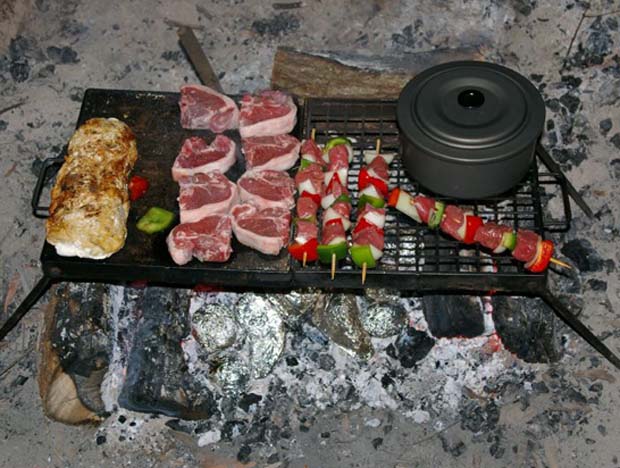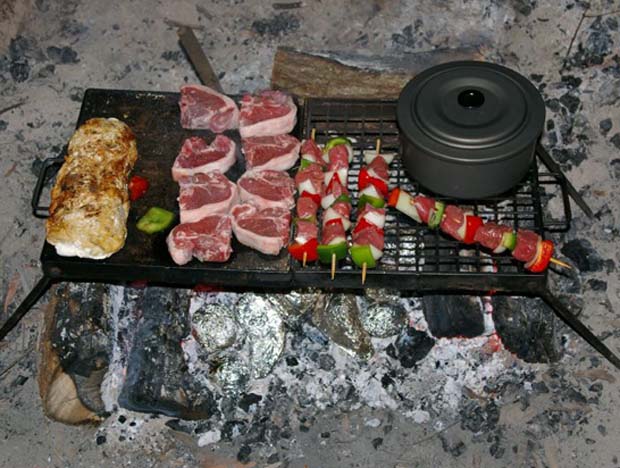[dropcap]B[/dropcap]efore you hit the trail for a fishing trip with a picnic in mind you should think about how to keep your foods safe and healthy on your warm weather outings. Cases of foodborne illness normally rise during summer because harmful bacteria that may be present in foods grow faster in the warm temperatures. And, since bacteria also need moisture to flourish, warm, humid summer weather is just a picnic for them!
To keep your picnicking safe from foodborne illness, follow these four simple steps to safer food in the summertime
[highlight color=”black”]CLEAN[/highlight]: Wash hands and surfaces often. Unwashed hands and surfaces are perfect for bacteria to make their way into the food. Often at a picnic or campsite, hand-washing facilities are not readily available. In those cases where there is no water, pack clean, wet, disposable cloths or moist towelettes and paper towels for cleaning hands and surfaces. Plan the menu carefully so you don’t have raw meats and poultry on cutting boards that can’t be cleaned without soap and water and plenty of it.
 [highlight color=”black”]SEPARATE[/highlight]: Don’t cross-contaminate. When packing the cooler for an outing, it is best to take one cooler for raw meats, poultry, fish and eggs, and a separate cooler for ready-to-eat foods. If only one cooler is used, it is essential to wrap raw meat and poultry very securely to prevent juices from coming in contact with ready-to-eat food. If serving a food that will be marinated, marinate it in the refrigerator before you leave home or in the cooler with ice, not out at room temperature or outdoors on the table. Use clean plates and utensils with the safely cooked food,not the ones with raw meat juices on them.
[highlight color=”black”]SEPARATE[/highlight]: Don’t cross-contaminate. When packing the cooler for an outing, it is best to take one cooler for raw meats, poultry, fish and eggs, and a separate cooler for ready-to-eat foods. If only one cooler is used, it is essential to wrap raw meat and poultry very securely to prevent juices from coming in contact with ready-to-eat food. If serving a food that will be marinated, marinate it in the refrigerator before you leave home or in the cooler with ice, not out at room temperature or outdoors on the table. Use clean plates and utensils with the safely cooked food,not the ones with raw meat juices on them.
[highlight color=”black”]COOK[/highlight]: Cook to proper temperatures. Food is safely cooked when it reaches the correct internal temperature needed to kill harmful bacteria that cause food borne illness. Take along a food thermometer. Meat and poultry cooked on a grill often browns very fast on the outside, so be sure that the items are cooked thoroughly. Cook hamburger and other ground meats (veal, lamb, and pork) to an internal temperature of 160°F. Partial cooking of food ahead of time allows bacteria to multiply to the point that subsequent cooking cannot destroy them. Plan to cook meat and poultry completely at the picnic site.
[highlight color=”black”]CHILL[/highlight]: Refrigerate promptly. Holding food at the incorrect temperature is a prime cause of foodborne illness. Never leave food in the “danger zone” (40°F-140°F) for more than two hours or one hour in temperatures above 90°F. Cold foods like luncheon meats, cooked meats, chicken and potato or pasta salads should be kept in an insulated cooler with lots of ice or frozen gel packs. Keep the cooler in the coolest part of the car, and place in the shade or shelter, out of the sun, whenever possible. Chill cold drinks in a separate cooler so the cooler with the perishable foods is not constantly being opened.
University of Georgia Cooperative


